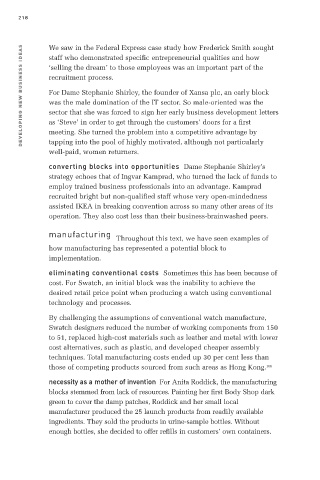Page 241 - DNBI_A01.QXD
P. 241
DEVELOPING NEW BUSINESS IDEAS218
We saw in the Federal Express case study how Frederick Smith sought
staff who demonstrated specific entrepreneurial qualities and how
‘selling the dream’ to those employees was an important part of the
recruitment process.
For Dame Stephanie Shirley, the founder of Xansa plc, an early block
was the male domination of the IT sector. So male-oriented was the
sector that she was forced to sign her early business development letters
as ‘Steve’ in order to get through the customers’ doors for a first
meeting. She turned the problem into a competitive advantage by
tapping into the pool of highly motivated, although not particularly
well-paid, women returners.
converting blocks into opportunities Dame Stephanie Shirley’s
strategy echoes that of Ingvar Kamprad, who turned the lack of funds to
employ trained business professionals into an advantage. Kamprad
recruited bright but non-qualified staff whose very open-mindedness
assisted IKEA in breaking convention across so many other areas of its
operation. They also cost less than their business-brainwashed peers.
manufacturing Throughout this text, we have seen examples of
how manufacturing has represented a potential block to
implementation.
eliminating conventional costs Sometimes this has been because of
cost. For Swatch, an initial block was the inability to achieve the
desired retail price point when producing a watch using conventional
technology and processes.
By challenging the assumptions of conventional watch manufacture,
Swatch designers reduced the number of working components from 150
to 51, replaced high-cost materials such as leather and metal with lower
cost alternatives, such as plastic, and developed cheaper assembly
techniques. Total manufacturing costs ended up 30 per cent less than
those of competing products sourced from such areas as Hong Kong.166
necessity as a mother of invention For Anita Roddick, the manufacturing
blocks stemmed from lack of resources. Painting her first Body Shop dark
green to cover the damp patches, Roddick and her small local
manufacturer produced the 25 launch products from readily available
ingredients. They sold the products in urine-sample bottles. Without
enough bottles, she decided to offer refills in customers’ own containers.

